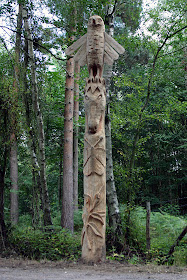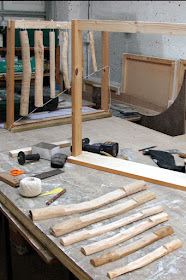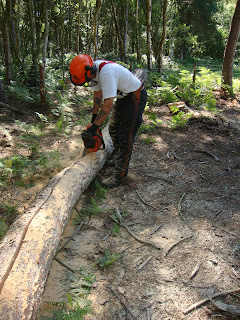 |
| Someone dressed the 'Drover' especially for Xmas, and his pigs! (willow sculpture by Alan Sage) |
Pages
▼
Saturday, 24 December 2011
Monday, 17 October 2011
The Best Bits
So the Wildart Trail has officially opened now and vitually everything is installed.
So this post is a small selection of photos showing the finished works.
 |
| Raptor: a symbol for the Wildart Trail and the wider Blean Project |
So the Wildart Trail has officially opened now and vitually everything is installed.
So this post is a small selection of photos showing the finished works.
 |
| detail from the woodland workshop |
 |
| unusuall to see th konic ponies here |
 |
| is this guy whistling as he takes his pigs to market walking along the Radfall on his way to Canterbury |
 |
| Bugton Underwood; where the insects live |
 |
| counting tree rings |
 |
| Heron |
 |
| A Totem Post (pupils at Herne Junior School) |
 |
| woodpecker |
 |
| lady of the Woods |
 |
| these are now known as the 'stump routings' |
 |
| The Arch |
 |
| the Sparrow Hawk and Konic Pony Totem Pole |
Tuesday, 11 October 2011
A day alongside KWT Volunteers
I spent the whole day working alongside the KWT Volunteers, I had my agenda and they had theirs. They were clearing areas of trees along the path improving the habitat by breaking the path corridor effect, which can act as a wind tunnel not so good for insect type wildlife.
I was stripping leaves from branches and was glad of passing converstion. Interesting hearing about peoples different backgrounds and walks of life. This band of helpers rotate around various KWT sites during the week. Focus on the Bidbury site one guy was telling me. Another lived in London (all be it on the wrong side of the river) but plenty in common to talk about. Others had foriegn holidays, amusing dog stories and I enjoyed my day with them. They made me tea, and shared chocolate cakes and this is welcome as the work is fairly physical.

In the afternoon one volunteer was kind enough to find time to help me and Kathryn fill one of the insect homes with sticks and twigs etc which helped a move things along for the opening event on Sunday.
These log cabins take quite alot of material and we spent the whole afternoon sawing wood to the correct length. One passer buy suggested we set up a xmas nativity scene in there, which would work. It might mean changing the accepted characters and replace them with wild life ones.
There's no room in the car park, 3 owls for the wise men, bringing acorns, chestnuts and wild mushrooms who were guided by the red lights on wind turbines on the horizon. We got ponies and highland cattle to watch, we might have a woodpecker as Joseph the carpenter. But I'm struggling to find replacements for Jesus and Mary?
 |
| fire: always an event even if just burning waste |
I was stripping leaves from branches and was glad of passing converstion. Interesting hearing about peoples different backgrounds and walks of life. This band of helpers rotate around various KWT sites during the week. Focus on the Bidbury site one guy was telling me. Another lived in London (all be it on the wrong side of the river) but plenty in common to talk about. Others had foriegn holidays, amusing dog stories and I enjoyed my day with them. They made me tea, and shared chocolate cakes and this is welcome as the work is fairly physical.

In the afternoon one volunteer was kind enough to find time to help me and Kathryn fill one of the insect homes with sticks and twigs etc which helped a move things along for the opening event on Sunday.
These log cabins take quite alot of material and we spent the whole afternoon sawing wood to the correct length. One passer buy suggested we set up a xmas nativity scene in there, which would work. It might mean changing the accepted characters and replace them with wild life ones.
There's no room in the car park, 3 owls for the wise men, bringing acorns, chestnuts and wild mushrooms who were guided by the red lights on wind turbines on the horizon. We got ponies and highland cattle to watch, we might have a woodpecker as Joseph the carpenter. But I'm struggling to find replacements for Jesus and Mary?
Sunday, 9 October 2011
A Map of the Wildart Trail in Thornden Woods
Here is the final version of the map which will mark the entrance of the trail. It lists all the features that can be seen along the trail.....er.erhm one or two are till in the construction phase. Looking forward to the Opening Day where the trail is officially opened to to public on Sunday 16th Oct. It has been open to the public all the way through construction really, but the chance for everybody to meet everybody and see whats happening in the woodland workshop.
 |
| The Wildart Trail |
 |
| the finished map at the start of the trail |
Friday, 30 September 2011
Wildart Tailblaze
This is official opening of the Wildart Trail. This is the cullmination of something like a year working with Kent Wildlife Trust on their Blean Project.
I had a conversation in the woods today with a dog walker who had walked his dog for ten years in the woodland. He said there was a noticible increase in people using the woods, you know for leisure walking, school trips and wheel chair special needs organisations bringing group outings, this increase in the last couple of years. He also said he'd seen a lot more animials recently, slow worms, more spieces of birds, lizards and even snakes! I hope this guy comes to this opening event and tells the same storey to Kent Wildlife Trust as that is the whole point and their aims fulfilled. I am delighted to have played a role in project.
Wednesday, 21 September 2011
Thursday, 8 September 2011
Willow Weaving Techniques
We have created a place on the Wildart Trail called the 'Coppice Demonstration Area'. This is a flexible space where copicing techniques and skills are displayed, demonstrated and and this case practical workshops carried out. On this occasion by Alan Sage, who ran this 'willow weaving techniques' workshop for Students at Christ Church University and staff from the Kent Wildlife Trust.
 |
| Anticipation: looking in Alan's basket of tools |
I'm unable to pass on the skills we learned on this blog, but we learned discrete knots to join work together, how to add shapes onto a form that your already working on, plaiting, basic basket weaving and unusual hair pins?
 |
| 'and that's all there is to it'! |
 |
| unusual hair pins |
The previous workshop we had created large ants, using a random weaving technique, but this was much more structured and required concentration to follow systematic repeated sequences. Speaking from a peronal view point I found that almost every length of willow I use...somehow I manage to kink, creating weak points, combined my reluctance or lazyness to chop off the stouter portions or 'butts' which then warp my creations out of shape, as the forces I have created within the structure compete. I wrestled for a long time with my fish, which in the end was a conifer tree. Other people managed fins, gills, tails and patterns for scales.
The final exercise was to cretae a sun flower and I had more success. A very enjoyable day, thanks again to Kent Wildlife Trust for oranising this and thanks to Alan Sage for passing his considerable knowledge on.
Here is a link to a slide show covering the days activities click here
Tuesday, 6 September 2011
A busy day down the woods
Everybody was in the woods today, it was busy and Cosmo was well in on the action. Its not often you can take your dog to work (unless your Fletcher who goes to work everyday).
 |
| the final 'totem post goes in, with designs by Philip Howard Catholic Primary School |
 |
| what am I looking at? |
 |
| woodpeckers |
 |
| they started off like this |
I was up and down the ladder a few times attaching these to trees. This oak which I thought was dead, but after it was choped right back to its trunk especially for these woodpeckers. Little shoots started growing and it has sprung to life.
 |
| we made this bench as well |
 |
| what am I looking for? |
 |
| the last post |
Entrance Arch
Whale Bone Arch was a working title for this feature which described it very well, even though it has nothing to do with whale bones. There were several particularly curved pine trees growing yards from the entrance. I guess this curved trunk is caused by the tree moving to reach more day light?
John from Kent Wildlife Trust identified which was the best one to use and felled it with a chain saw.
Neither of us could really tell how this was going to look or what was the best way to install this thing and it lay on the floor for a couple of weeks waiting to be installed near the entrance. I walked past it several times with Cosmo, looking at it wondering if it would be easier and to install it with the bits I had imagined being in the ground, sticking up in the air. This would avoid having to cut a difficult mitre join during the installation.
John from Kent Wildlife Trust identified which was the best one to use and felled it with a chain saw.
 |
| the chosen tree |
 |
| he's done this before I can tell |
After quick work by John the tree was down, and I had not even managed to video it....
The branches wiped off quick and in no time
the tree is ready for the next stage
the tree is ready for the next stage
The next stage is a tricky cut running along the whole length of the tree.
By leaving the two ends still joined and cutting the middle, then doing the ends last. It is essential to get a smooth cut as this will form the new face
Neither of us could really tell how this was going to look or what was the best way to install this thing and it lay on the floor for a couple of weeks waiting to be installed near the entrance. I walked past it several times with Cosmo, looking at it wondering if it would be easier and to install it with the bits I had imagined being in the ground, sticking up in the air. This would avoid having to cut a difficult mitre join during the installation.
John had been thinking exactly the same thing as installation was hard enough already.
 |
| view from the trail |
 |
| view from the main path |
So, the feature is very firmly in and stable, while the surounding birch trees wil be cut back or removed to clear the view. How to decorate it, and what be appropriate is the next decision? This will wait a while as other features are going in and have priority. We can't call it the whale bone arch anymore as it does not look like one so much anymore and a bottle kiln is urban not woodland, so again its just sitting at the back of my mind. A spiders web with concentric rings and a circular hole in the centre is where my thoughts for it are right now!
What is very odd, is that from the main path you can't even see it, yet it must be approching 25 feet tall. The bark makes it blend in with its surroundings. A threshold you dont realise your crossing or an invisable door. Approach it from the other side and it is much more visable. I expect it will transform again when the surounding trees are trimmed back or possibly removed altogether.
 |
| the installed arch. |
Friday, 2 September 2011
Xylophone Experiments?
See now........ what you have are pentatonic or diatonic scales, and dissonance is often a problem on chromatic instruments......er......... fine......I have no musical knowledge whatsoever, but I have really enjoyed just experimenting with this. I think technically speaking I am collecting empirical evidence and data for application when constructing the instrument on a larger scale.
Actually I am just making trial and error experiments on a model xylophone. Choosing small logs of different thickness and cutting them to different lengths. Some I have cut in half longways and removed a lot of wood from the back, hoping this would make them sound better than just a plain log. I googled xylophones and found out that if you measure 22.5% of the total lengh in from each end to find the 'nodes', alternatively you could use the 'sprinkling salt' method?
My logs are going to be hung vertically, so the location of nodes and support under them seems a little irrelevant, it does change the sound of the log but whose to say it sounds better than just a plain log? I can't.
These sound different to just plain logs, and I quite like the smooth flat face to engrave designs on. I had to invent ways off attaching them so they stopped spinning round and round when played. With the back scooped off they look like they might have been made by someone who knew what they were doing?
The whole logs produce a different sound and I cant tell which is best I will have to consult with my friends at Kent Wildlife Trust. Practically speaking it appears to me that both work just as well, though some pieces of wood are just naff sounding if they are a bit soft or damp, or may be just too small. What you hit the logs with also makes a difference, whether it is a piece of rebar (metal) which is what I used or just another piece of wood? So there are a lot of variables none seem particularly wrong, but then I can't hardly tell if notes go higher or lower.
What I do really like is carving patterns which wrap around the logs, it makes the instrument look rather primeval.......like my musical abilities.
Actually I am just making trial and error experiments on a model xylophone. Choosing small logs of different thickness and cutting them to different lengths. Some I have cut in half longways and removed a lot of wood from the back, hoping this would make them sound better than just a plain log. I googled xylophones and found out that if you measure 22.5% of the total lengh in from each end to find the 'nodes', alternatively you could use the 'sprinkling salt' method?
 |
| empirical experiments |
 |
| my experiment with logs cut in half |
 |
| my experiment with whole logs |
What I do really like is carving patterns which wrap around the logs, it makes the instrument look rather primeval.......like my musical abilities.
Saturday, 27 August 2011
Totem Poles in the Paper
It is always nice to see what you've done in the paper, my friends and relatives certainly have and contacted me to tell me. These poles have been in a a few weeks now and I can see the freshly cut wood just starting to change colour. I guess they will eventually turn a silver grey colour.
In the kitchen yesterday, my youngest daughter shouted 'whats that bird on the garden fence'? We all looked round to see what we think was probably either a Goshawk or more likely to have been a sparrow hawk fly off across the back gardens of our neighbours. Coincidence as the I never seen any thing like that in my garden ever before, yet a couple of weeks after the totem poles went in. A sparrow hawk is the basis for the bird of prey on the top of one. The joke at the time when carving it was that I should paint it black, as it has a swept back appearence resembling a stealth bomber.
 |
| right to left: Kathryn Barton, Rob Turner, Roger Day and a yellow telehandler |
In the kitchen yesterday, my youngest daughter shouted 'whats that bird on the garden fence'? We all looked round to see what we think was probably either a Goshawk or more likely to have been a sparrow hawk fly off across the back gardens of our neighbours. Coincidence as the I never seen any thing like that in my garden ever before, yet a couple of weeks after the totem poles went in. A sparrow hawk is the basis for the bird of prey on the top of one. The joke at the time when carving it was that I should paint it black, as it has a swept back appearence resembling a stealth bomber.
 |
| bird of prey based on a sparrow hawk |
There will be other features installed along the Wildart Trail over the next few months or so.













